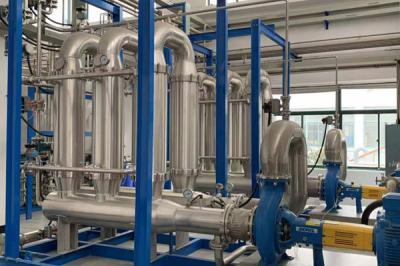Surface water, as the source of drinking water in a considerable area of China, however, is more susceptible to interference from external factors and becomes a slightly polluted drinking water source. Purification of micro-polluted water is a huge challenge faced by traditional drinking water plants. Moreover, with the improvement of drinking water hygiene standards and people's pursuit of high-quality drinking water, water plants that use traditional treatment processes (coagulation sedimentation filtration and disinfection) cannot treat micro-polluted raw water into qualified drinking water. The current common practice is to add advanced treatment technology based on traditional technology, such as activated carbon or ozone activated carbon. However, the upgrading of the treatment process leads to the extension of the process flow, the increase of the construction cost of the structure, and the increase in the cost of water production. Moreover, more importantly, many small and medium-sized water plants do not have reserved construction land and cannot carry out such upgrades. Therefore, the drinking water treatment industry urgently needs an effective new treatment process to replace the traditional treatment process, or to renovate the water plant on the basis of the original process to meet the requirements of the new water quality standard.
Membrane technology can effectively remove pathogenic bacteria, algae, particulate, and organic matter in drinking water. With the reduction of membrane preparation costs and the maturity of application technologies, membrane filtration technology has become increasingly widely used in drinking water treatment. Compared with traditional processes, membrane technology can reduce the use of chemical reagents, reduce the amount of sludge, and produce high-quality drinking water. It can also shorten the process flow and easily realize automated operation. Most of the membranes currently used are organic membranes. Although organic membranes have many advantages such as low price, easy installation, and high packing density, their mechanical strength, and chemical stability are poor, and broken wire or damage are easy to happen, leading to their short service life. Moreover, in order to enhance the coagulation effect, remove algae, heavy metals, odors, and trace pollutants, etc., oxidants need to be added in the water treatment process, and the oxidants will harm the organic membrane. Therefore, a film with high mechanical strength and oxidation resistance is needed to meet the requirements of the current water treatment process.
The ceramic flat sheet membrane is a new generation of inorganic ceramic membrane which is made of inorganic materials such as Al2O3, ZrO2, TiO2, SiO2, SiC, and is manufactured through the traditional Chinese sintering process for thousands of years and modern equipment. With the advantages of high mechanical strength, chemical stability, and thermal stability, it can withstand extreme environmental pollution and cleaning conditions and is suitable for use in drinking water treatment processes where oxidants are added. It is mainly based on the theory of "physical sieving". According to a certain membrane pore size range, different molecular diameters of penetrating substances have different permeability. Taking the pressure difference between the two sides of the membrane as the driving force, and the membrane as the filter medium, under certain pressure, when the material liquid flows over the surface of the membrane, only water, inorganic salts, and small molecules are allowed to pass through the membrane, while the suspension of water, glue and microorganisms, and other macromolecular substances are prevented from passing. It has the advantages of high filtration accuracy (pore size 0.1um), long service life, large energy, low energy consumption, pollution resistance, easy cleaning, small size, and small footprint.
In some countries and regions where economic conditions permit, ceramic membranes are increasingly used in drinking water treatment. After the ceramic membrane process is combined with other processes, it can achieve the function of removing turbidity, pathogenic microorganisms, and organic matter, and can reduce the disinfection by-products in the subsequent disinfection process. Therefore, in the current upgrade and transformation of water plants, ceramic membranes and their integrated processes have good application prospects. Research on ceramic membrane integration technology can provide strong support for the transformation of small water plants. The high mechanical strength of the ceramic membrane can cope with the abrasion of particles and realize the direct filtration of coagulation water. Moreover, its excellent chemical stability allows it to be used in conjunction with ozone and other oxidants to improve the removal of pollutants while reducing membrane pollution.




 +86-25-58849045
+86-25-58849045
 +86-25-58749295
+86-25-58749295
 jiuwu@jiuwu.com
jiuwu@jiuwu.com
 No. 9 Park Road, Pukou District, Nanjing City (Sanqiao Factory)
No. 9 Park Road, Pukou District, Nanjing City (Sanqiao Factory) Call us on:
Call us on:  Email Us:
Email Us:  No. 9 Park Road, Pukou District, Nanjing City (Sanqiao Factory)
No. 9 Park Road, Pukou District, Nanjing City (Sanqiao Factory)

 English
English 한국어
한국어 français
français русский
русский Español
Español

